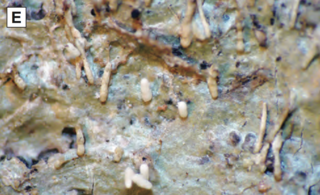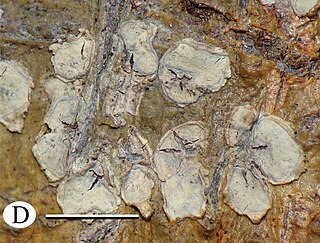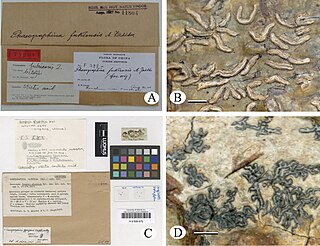
The Graphidaceae are a family of lichen-forming fungi in the order Graphidales. The family contains nearly a hundred genera and more than 2000 species. Although the family has a cosmopolitan distribution, most Graphidaceae species occur in tropical regions, and typically grow on bark.

Fissurina is a genus of lichenized fungi in the family Graphidaceae. It has about 160 species, most of which are found in tropical regions.

Acanthotrema is a genus of lichens in the family Graphidaceae. The genus was circumscribed by German lichenologist Andreas Frisch in 2006, with Acanthotrema brasilianum assigned as the type species. Acanthotrema species are commonly found in rainforests ranging from lowland to montane environments.

Astrochapsa is a genus of lichen-forming fungi in the subfamily Graphidoideae of the family Graphidaceae. It has 28 species. The genus was circumscribed by Sittiporn Parnmen, Robert Lücking, and H. Thorsten Lumbsch in 2012, with Astrochapsa astroidea assigned as the type species. It was segregated from the genus Chapsa, from which it differs in having a more frequently densely corticate thallus, an apothecial margin that is mostly recurved, and the almost exclusively subdistoseptate, non-amyloid ascospores.
Wirthiotrema is a genus of lichen-forming fungi in the family Graphidaceae. The genus was circumscribed in 2010 by Eimy Rivas Plata, Klaus Kalb, Andreas Frisch, and H. Thorsten Lumbsch, with Wirthiotrema glaucopallens assigned as the type species. Wirthiotrema contains species that were formerly considered part of the Thelotrema glaucopallens species group. The genus name honours lichenologist Volkmar Wirth, "for his numerous outstanding contributions to lichenology".
Halegrapha is a genus of lichen-forming fungi in the family Graphidaceae. It has nine species. The genus was circumscribed in 2011 by Eimy Rivas Plata and Robert Lücking, with Halegrapha chimaera assigned as the type species. The generic name honors American lichenologist Mason Hale.
Rhabdodiscus is a genus of script lichens in the family Graphidaceae. It has 36 species.
Pseudochapsa is a genus of lichen-forming fungi in the family Graphidaceae. It has 19 species. It was circumscribed in 2012 by Sittiporn Parnmen, Robert Lücking, and Helge Thorsten Lumbsch, with Pseudochapsa dilatata as the type species. Pseudochapsa differs from Chapsa it that its excipulum is typically brown. Additionally, its ascospores are mostly discoseptate and amyloid. The generic name combines the Greek pseudo ("false") with the genus name Chapsa.
Cruentotrema is a genus of corticolous (bark-dwelling) lichens in the family Graphidaceae. It has seven species.

Graphidales is an order of lichen-forming fungi in the class Lecanoromycetes. It contains 6 families, about 81 genera and about 2,228 species. Family Graphidaceae are the largest crustose family within Graphidales order comprising more than 2000 species, which are widely distributed in tropical and subtropical regions of the world.
Clandestinotrema is a genus of lichen-forming fungi in the family Graphidaceae. It has 17 species. They typically inhabit montane and cloud forest at higher elevations in the tropics.
Topeliopsis acutispora is a species of crustose lichen in the family Graphidaceae. It is found in New South Wales and southern Queensland (Australia), where it grows on bryophytes.
Redonographa is a genus of lichen-forming fungi in the monogeneric family Redonographaceae. It has five species.
Gintarasia is a genus of lichen-forming fungi in the family Graphidaceae. It has seven species, all of which are found in Australia. Gintarasia species are corticolous (bark-dwelling), crustose lichens with a thelotremoid form.

Acanthotrema alboisidiatum is a species of corticolous (bark-dwelling) crustose lichen in the family Graphidaceae. Described as a new species in 2014, it is primarily distinguished by its striking white isidia that contrast with its light olive-green thallus. The lichen was recognized as a new species despite the absence of ascomata and ascospores, usually crucial for taxonomic identification. Its DNA sequence data confirms its place in the Acanthotrema genus but distinguishes it from other known members of this genus. The species grows up to a diameter of 5 cm (2 in) and bears short, white isidiate outgrowths that resemble insect eggs. The lichen appears to favour the shaded understory of Tabonuco forests in El Yunque National Forest, Puerto Rico, particularly towards the base of Dacryodes excelsa trees.
Compositrema cerebriforme is a species of corticolous (bark-dwelling) lichen in the family Graphidaceae. It is notable for its distinct structure and resemblance to the shape of a brain. It was discovered in the greenery of Venezuela's Henri Pittier National Park, and described as a new species in 2012.
Compositrema thailandicum is a species of corticolous (bark-dwelling) lichen in the family Graphidaceae. Found in tropical Thailand, it was described as a new species in 2012. The lichen is distinguished by its unique physical characteristics and its notable similarities to, and differences from, other species within the same family.
Ocellularia vulcanisorediata is a rare species of corticolous (bark-dwelling) lichen in the family Graphidaceae. Described as a new species in 2014, it is only known to occur in Puerto Rico.
Thalloloma rubromarginatum is a little-known species of corticolous (bark-dwelling) script lichen in the family Graphidaceae. This lichen stands out from its counterparts within its genus, most notably Thalloloma haemographum, due to its corticate thallus and the presence of norstictic acid. Thalloloma rubromarginatum is found in the Sierra palm forests of Puerto Rico.




